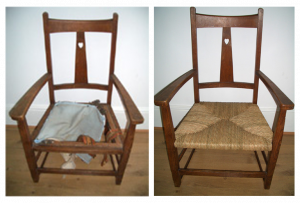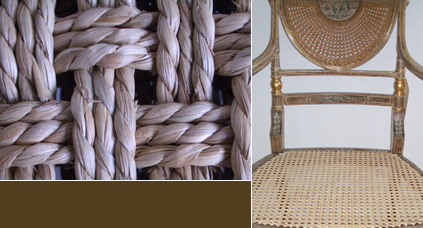Please Note I am now only repairing and restoring cane and danish cord.
a bit about kevin
Kevin learned his craft many years ago. A retired upholsterer kindly and painstakingly passed on the experience of a lifetime.
Hundreds of items pass through this busy workshop, from French beds to teapot handles, from simple bedroom chairs to bergere suites.
Kevin works with major upholsterers, antique dealers and interior designers. But many clients come to him directly. They quickly realise that each much-loved item will be treated with great respect and given a new lease of life.
Please see the gallery for examples of his work.
a bit about cane
Chair Cane is formed by peeling off the outer bark of the thorny, climbing palm known as Rattan palm which grows in the tropical forests of Malaysia, Indonesia and the Philippines. The long strips are cut into various widths for use in chair caning.
Hand Caning is when separate layers (usually six) of rattan (cane) are woven through the holes in the frame of a piece of furniture to form a particular pattern. The size of cane used is governed by the distance between the holes in the frame. Cane can be stained (to match existing cane or that of matching chairs).
Blind Caning is the term used to describe a chair that has been designed so that there is no cane stitching on the reverse side of the frame. To achieve the pattern each strand is individually woven in short lengths and pegged into the holes. This usually occurs only on antique furniture. If your chair is a contemporary piece then the lack of stitching may indicate that it is Sheet Caned.
Sheet Caning is common on contemporary furniture. The cane is pre-woven and is secured to the chair frame by way of a routed out groove and held in place by a glued-in strip of spline.
I also work with Natural Rush, Fibre Rush, Seagrass, Danish Cord & Cotton cord.
testimonials
“I was thrilled with the chair Kevin re-rushed for me.”
“I felt I had to write to say a special thank-you… I would certainly recommend your service to anyone.”
“When you need someone to cane a chair, Kevin Hubbard is your man.”
“Kevin’s work is of the highest quality.”
before & after

An example of what Kevin can do for your negleted chairs…
history of caning
Woven cane as a method of chair seating was first introduced into England during the second half of the 17th century. To begin with the holes in the chair framework were very widely spaced apart giving a coarse and unattractive weave. As time passed, the canework became finer and more closely woven eventually giving us the fine six way pattern that we are familiar with today.
The popularity of cane as a seating material has remained virtually constant in Europe where even today a good percentage of modern furniture has some canework either for its decorative qualities or for its practicality.
During the Regency period many “faux” bamboo chairs were made, some with finely crafted cane seats. The Brighton Pavilion was a trend setter, and as its style was based around Far Eastern influences, rattan and bamboo became popular. English furniture manufacturers wanted to reflect this style and so cane seating became more widely recognised.
Since then a revival of Regency style at the turn of the 20th century saw an increase in the number of pieces of furniture using cane, Bergere salon suites became popular with their cane back and side panels and almost everyone had a dainty little cane seated bedroom chair.
Many of these Edwardian pieces are highly prized now and therefore the caneworker’s art is making a comeback.
Many thanks to Kim R for supplying the ‘History of caning’ text.
 Caner
Caner